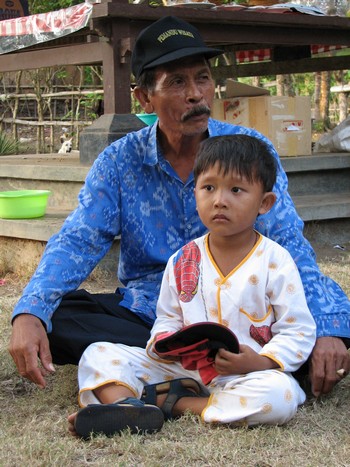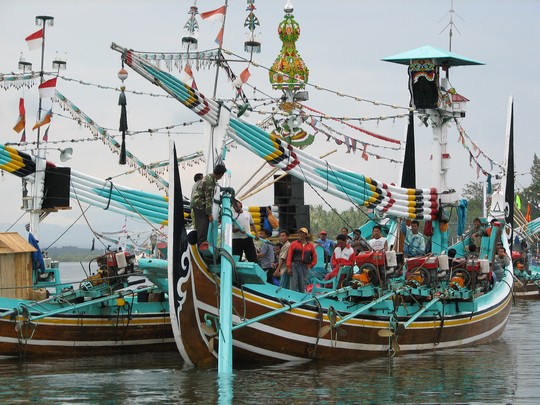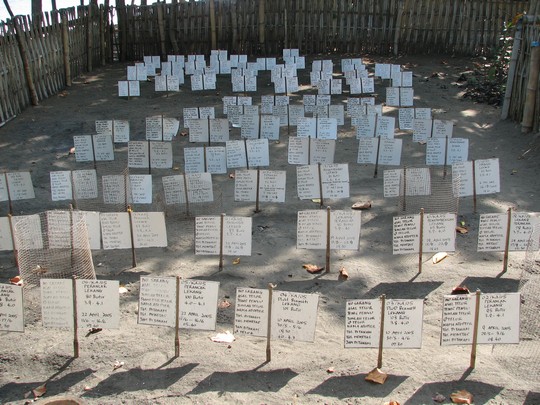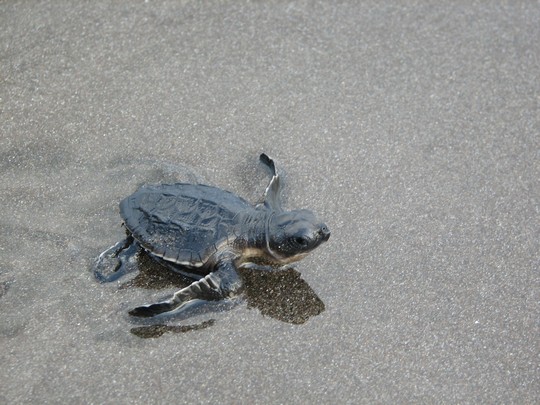A community in western Bali hopes that government regulation and a shift to eco-tourism will save it from the decline of its traditional fishing industry
Carol Warren
Lying on a long stretch of beach at the meeting point between the Indian Ocean and the Perancak River, the idyllic village of Perancak had until recently escaped the attention of the tourism industry enveloping so much of the rest of Bali. The three hour drive west of the capital Denpasar has been a great enough distance to inhibit all but a trickle of visitors, despite some exceptional attractions.
I went to Perancak for the first time in 2001 to research the turtle conservation project initiated by a group of former turtle hunters, a project that has since become the most successful effort on the island to safeguard turtle nesting sites along its beaches. The lucrative turtle trade had by the 1990s almost completely wiped out local populations. By then it was drawing in sea turtles from as far as Sulawesi and Papua to meet the demand for turtle meat, a delicacy particularly popular in the wealthy urban and tourist centres of southern Bali.
Wayan Tirtha, the founder of the Kurma Asih ‘Turtle Carers’ group, hopes that eco-tourism will develop in the area in order to support the group’s turtle conservation activities. Income from tourists, he hopes, will give local communities an incentive to enforce the law and protect turtles and the increasing numbers of eggs they lay during nesting season along the beaches of Perancak and adjacent communities.
Hoping for green tourism
This desire for an eco-tourism option is shared by the wider community. Many villagers see tourism as a way to supplement the fishing industry income on which they are almost entirely dependent. Indeed, one of the most spectacular sights greeting visitors to the village, and yet to be promoted by the tourism industry, is the fleet of large brightly painted and elaborately decorated ships anchored in the Perancak river. Every day more than a hundred of these stunning vessels – known locally as ‘perahu Madura’, after the island of Madura where the boat style originates – exit the river in pairs on their way to fishing grounds as far afield as Jimbaran, 90 kilometres to the southeast.
 |
|
Wayan Tirtha with his grandson/Carol Warren |
The extraordinary experiences of releasing little sea turtle hatchlings, viewing the daily procession of the perahu Madura, listening to the mellow sounds of the distinctive jegog bamboo orchestra of West Bali, and soaking up the pleasant atmosphere of Perancak village should make it an ideal destination for alternative tourists. Beyond sight, however, some serious environmental issues threaten local dreams. The Perancak coast is eroding at the rate of several metres each year, and locals have felt pressed to sell land along the coastal strip to outside investors, before they lose their assets to rising seas, and in the hope of gaining more secure employment for their children.
The main occupations available in the village remain small-scale line and net fishing from traditional Balinese outrigger jukung boats, or work as labourers for a share of the catch on the large perahu Madura. These employ 20 to 35 crew per pair of boats and can haul as much as 30 tons of fish worth 80 to 300 million rupiah (US$9000-35,000) on a good day in high season. But both options in the fishing industry are in decline as seasonal weather patterns become more extreme and less predictable, and because over-fishing threatens the resource base.
In 2010-11, fishers of both types complained of the long ‘season of scarcity’ (paceklik panjang), when catches didn’t even cover costs. For some years now, the exquisite perahu Madura have become a source of tension in the village, despite the fact that many traditional fishers also earn income from part-time work on the larger commercial boats. At issue is the use by the perahu Madura owners of illegal purse seine nets with a net hole size (mata jaring) of only one centimetre, when national regulations set a minimum of one inch.
The failure of the government to enforce regulations controlling net types, zones for different boat sizes and fishing technologies, or to limit the size and number of boats chasing declining fish numbers troubled the traditional fishers, faced with this long ‘season of scarcity’ in what should have been high fishing season.
 |
|
Perahu Madura in the Perancak River / Carol Warren |
Ketut Sudiarna, head of one of the local fishers’ groups, complained: ‘The government doesn’t put any limits on the size or number of boats, or the nets used. One person for example can own 15 boats with a capacity of 40 to 70 tons, and use nets with holes as small as one centimetre. Imagine when they all go out to sea, all the fish are dredged. Fish as thin as a pen are taken; how is it possible for the fish to grow large? How can we small jukung fishers make a living when the fish are all gone? If the large boats were regulated and everyone stuck to the zoning rules, and the net sizes were seven to ten centimentres, then the large and small fishers could both make a living…. If the Fisheries Department doesn’t do something about regulating this, the next generation won’t even know the names of these fish, because there won’t be any left.’
Wayan Tirtha, was similarly critical. ‘The regulations are there…. but the sanctions aren’t. They tell us not to use bombs for fishing. But what’s the difference if they don’t prevent the use of nets like this? It’s suicide. And here’s the proof – the fish aren’t there! If I were the minister, I wouldn’t give permits to sell nets that size, I’d enforce the rules on trawling, and put a no take zone just off the coast…We are conscious that what there is in the sea, we have to protect for the future.’
Not only has there been no heed from the government of these wise words from the ‘little’ fishers of Perancak, the Minister of Oceans and Fisheries is planning instead a ‘blue revolution’ to raise Indonesia’s production from 12 to 22 million tons by 2014. Meanwhile, the ‘long season of scarcity’ continues, compounded by increasingly wild and unpredictable weather patterns. More and more West Bali fishers are unable to go to sea and are desperately seeking other sources of livelihood.
The Turtle Carers of Perancak
The turtle conservation efforts at Perancak have experienced a quite different set of pressures. The Kurma Asih Turtle Conservation Group was founded in 1997 by Wayan Tirtha, a village customary (adat) leader, and members of his extended family, who had traditionally been turtle hunters. Influenced by a WWF campaign to halt the trade in endangered and threatened sea turtles, illegal in Indonesia since a government ban in 1990, they approached the conservation organisation to establish a protection program. They have since maintained this program for more than a decade with great success. The number of nestings and transfers to safe locations rose steadily from four nests in 1997, their first year of operation, to more than 450 in 2010.
Members of Kurma Asih patrol the Perancak beach during the six months of the nesting season and transfer the nests they find to safe enclosures, where each is marked with a sign indicating species, date of laying, number of eggs and expected hatching date.
 |
|
Kurma Asih turtle nest sanctuary and hatchery / Carol Warren |
Almost all of the nests along the Perancak beach are laid by Olive Ridley turtles (known locally as lekang), a threatened sea turtle species that prefers black sand. One of the Olive Ridleys nesting at Perancak, tagged in 2009 by a French researcher working with the Indonesian Government Ocean Research and Observation station, was later tracked travelling as far as Sulawesi.
But the turtle project at Perancak has the opposite problem of the Perancak village fishers. While the fishers face too few fish, the conservation group are struggling to manage too many turtles. Kurma Asih now has more turtle nests than the small number of nest adoptions and donations from the few passing tourists can support.
Meanwhile, plans of investors to buy up the beachfront property for exclusive hotel or private villa developments threaten the nesting sites along the beach of this still quiet fishing village. Ultimately, Kurma Asih members hope that the governor’s push for ‘Clean and Green’ Bali will bring environmentally concerned eco-tourists to Bali’s beaches, instead of the mass tourists that flock to the island for sunbathing and night life. They hope that a new program intended to boost village-based, ecologically sensitive tourism will allow Balinese communities like Perancak to meet both their conservation and livelihood needs.
Perancak villagers can and do want to protect the environment and the endangered species that inhabit it. New approaches to tourism can help them do so, but there is a race against time, and a race against mass tourism, industrial scale fisheries and the other forms of unregulated commercialisation sweeping the island.
Carol Warren (c.warren@murdoch.edu.au) is Associate Professor in the Asia Research Centre at Murdoch University.
NOTE : Readers interested to visit Perancak to release a hatchling and enjoy the charms of this interesting village, can contact the Jaringan Ekowisata Bali (JED), an NGO operating on ethical community-based principles, to organise a trip that includes contributions to the Kurma Asih project and the local community. For more information visit www.jed.or.id.
Donations to the Kurma Asih project can be made through the Enviro-Friends Network (c/o r.donaldson@murdoch.edu.au).












